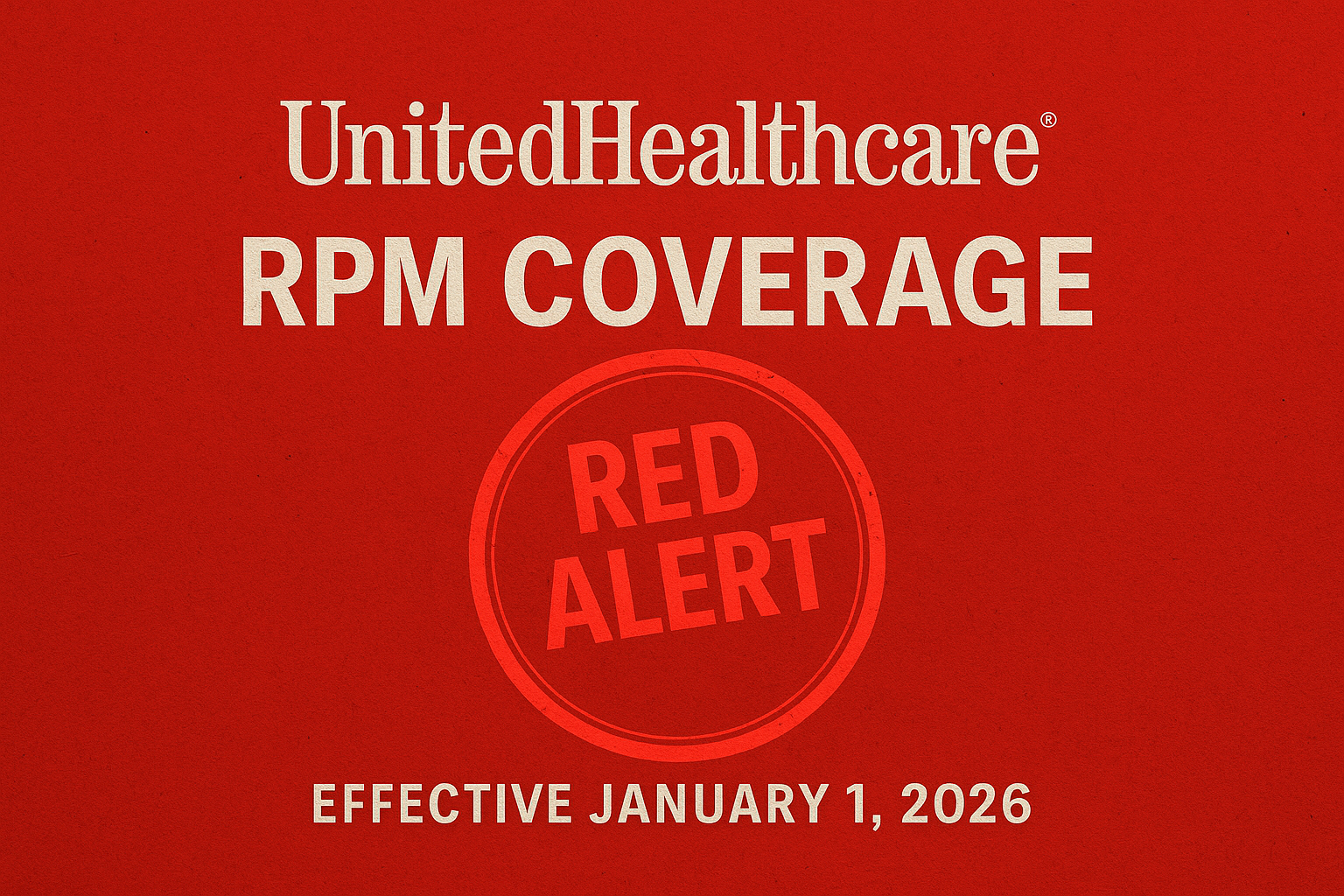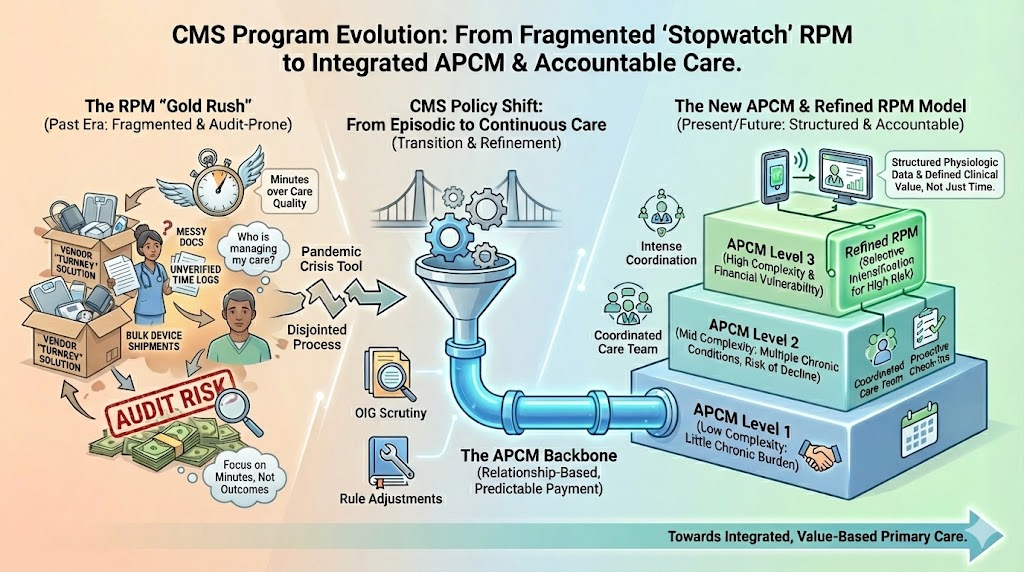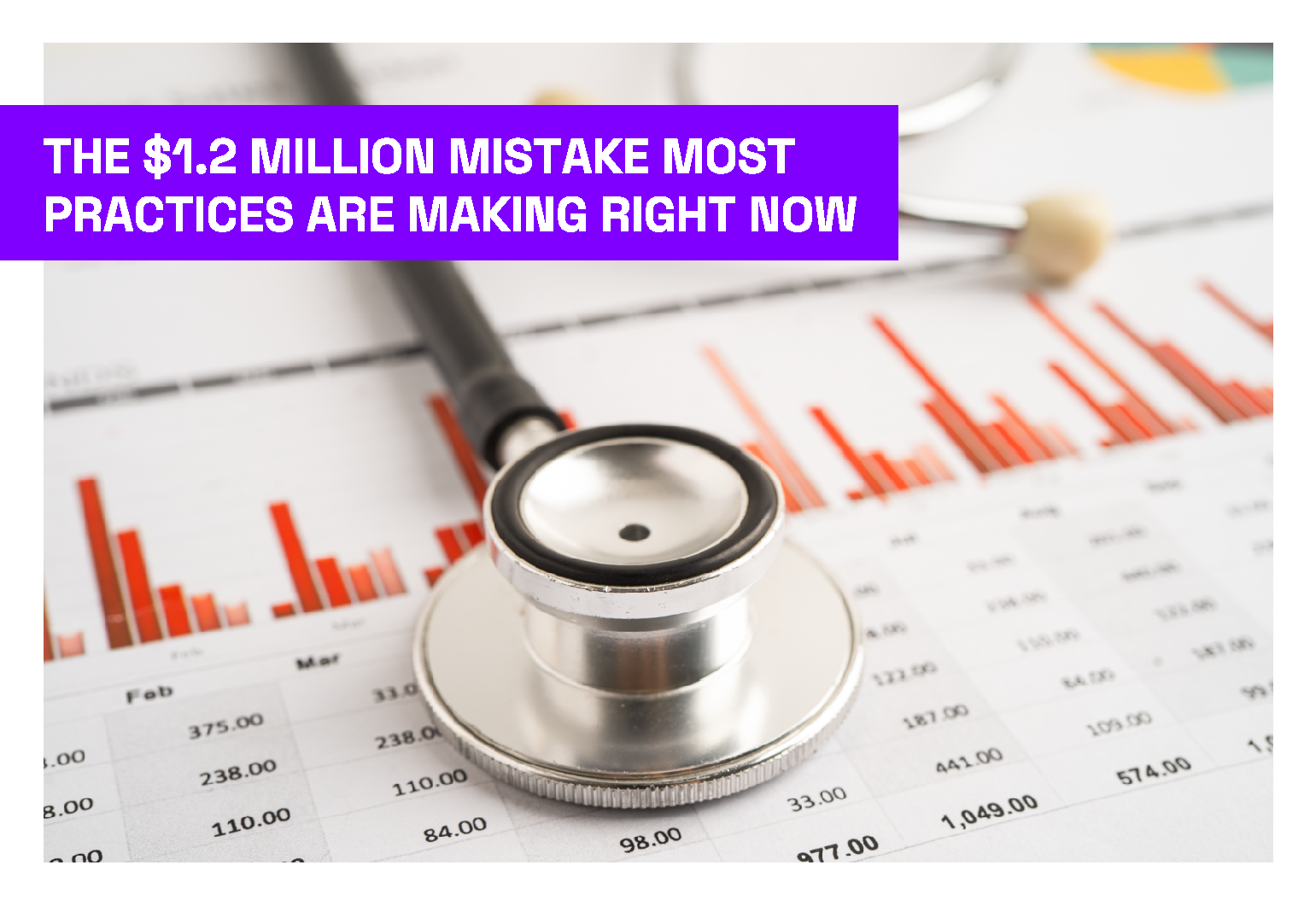The $1.2 Million Mistake Most Practices Are Making Right Now
If your practice adopted APCM by shutting down RPM and RTM programs, you left money on the table. If you're running all three programs separately, you're burning cash on duplicate documentation and exposing yourself to compliance risk.
The correct answer isn't either-or, its coordinated integration. Practices that get this right are generating $225-325 net margin per patient monthly while reducing administrative burden by up to 30%.
Here's how the economics actually work, and what separates winning practices from everyone else.
Why Practices Get This Wrong
CMS introduced APCM as a structural upgrade to care management, not a replacement for monitoring programs. Yet most practices treat it as one:
The Replacement Trap: Practices abandon profitable RPM and RTM programs, assuming APCM covers everything. It doesn't. You lose monitoring revenue and weaken care continuity.
The Silo Trap: Practices run all three programs independently, creating redundant workflows, conflicting documentation, and billing errors that invite audits.
Both approaches cost you money. The first sacrifices revenue. The second burns it on overhead.
The Integration Model: Three Programs, One System
Successful practices recognize that APCM, RPM, and RTM serve distinct clinical and financial functions:
APCM provides the overall care management structure—provider accountability, care planning, and transition management.
RPM and RTM deliver continuous patient data that drives specific interventions within that structure.
Integration means these programs share one care plan, one documentation system, and one accountability framework. You bill separately for each service, but you execute them as a unified operation.
What This Looks Like Operationally
Single Care Plan: RPM glucose readings or RTM therapy adherence data flow directly into the APCM care plan, triggering interventions automatically.
Unified Task Management: All outreach, education, and monitoring tasks appear on one centralized list—not scattered across three platforms.
Automated Documentation: Software captures activity in real time, meeting all program-specific billing requirements without duplicate data entry.
One Accountability System: Care navigators, nurses, and providers coordinate under a single supervisory framework rather than juggling separate program rules.
This eliminates the false trade-off between patient volume and compliance. Practices scale both simultaneously.
The Financial Case: Real Numbers from In-House Programs
Most practices running siloed programs capture $150-180 per patient monthly across RPM or basic care management. They're leaving significant reimbursement unclaimed.
Integrated in-house APCM + RPM + RTM programs using modern automation generate $250-350 per patient per month in combined reimbursement. Program costs run approximately $25 per patient monthly ($10 software, $15 per device rental).
Net margin per patient: $225-325 per month, depending on complexity and time documented.
Staffing efficiency compounds these gains. In siloed programs, a three-person care team (two RNs, one MA) manages 600-700 patients due to documentation overhead and system friction. Integrated systems with automation enable the same team to handle 900-1,000 patients while maintaining compliance.
The financial impact is substantial:
Traditional siloed model:
- 700 patients × $160/month = $112,000 monthly gross revenue
- Higher admin overhead, fragmented workflows
- Est. 40% margin after labor and overhead = $44,800 monthly profit
Integrated in-house model:
- 950 patients × $290/month = $275,500 monthly gross revenue
- ~$25/patient program costs = $23,750 monthly
- Same care team, 25% less admin time
- Est. 55% margin after all costs = $151,525 monthly profit
That's a $106,725 monthly difference, or $1.28 million annually, with identical headcount.
These figures reflect actual CMS reimbursement rates and reported results from practices running integrated programs in 2024-2025. The difference comes from eliminating waste and capturing all available compliant reimbursement—not from aggressive billing.
Clinical Scenarios Where Integration Drives Value
Chronic Disease Management (RPM + APCM)
A diabetes patient's RPM glucose monitor flags elevated readings. In an integrated system, those readings automatically update the APCM care plan and trigger an intervention protocol. One documentation event satisfies both programs' billing requirements.
Post-Surgical Rehabilitation (RTM + APCM)
A patient recovering from knee surgery stops engaging with home therapy exercises tracked through RTM. Integrated software alerts the APCM care team immediately, enabling intervention before outcomes deteriorate. Both programs bill compliantly from the same workflow.
Complex Post-Hospitalization Care (RPM + RTM + APCM)
A COPD patient discharged from the hospital needs breathing monitoring (RPM), therapy adherence tracking (RTM), and transition management (APCM). All three run from one system, preventing readmission while maximizing compliant reimbursement.
In each case, integration creates clinical value and financial value simultaneously—not by gaming the system, but by eliminating waste.
Compliance: The Four Non-Negotiables
Integration increases revenue only if you maintain clear program separation in documentation and billing:
Differentiate Services Clearly: Document what RPM, RTM, and APCM each provide. Never blur the lines.
Prevent Time Overlap: If you bill 20 minutes for APCM, that same 20 minutes cannot count toward RPM time requirements.
Document Care Transitions: APCM requires thorough transition documentation. Automate this wherever possible, but verify completeness.
Audit Monthly: Run internal reviews to catch billing errors before external audits do.
Automation handles most of this oversight, but governance remains essential. The practices that avoid trouble treat compliance as a system design problem, not a documentation problem.
Why Automation Is Non-Negotiable
Integration without automation is theory. Automation makes it operational reality.
Platforms like FairPath centralize patient records, automatically manage care tasks against billing criteria, and generate audit-ready documentation in real time. This isn't about convenience—it's about making integration financially viable.
Without automation, the administrative load of running three coordinated programs exceeds the efficiency gains. With automation, you unlock the full revenue potential while reducing overhead.
What to Do Next
If you're running APCM, RPM, or RTM in isolation, you're likely generating $150-180 per patient monthly—and leaving $100-170 per patient unclaimed. If you're avoiding APCM because you think it conflicts with existing programs, you're missing a seven-figure annual opportunity.
The strategic question isn't whether to integrate. It's how quickly you can operationalize integration with the right automation and cost structure to capture $225-325 net margin per patient.
Do This Next:
- Audit your current APCM, RPM, and RTM programs separately—identify overlap, gaps, and billing inefficiencies
- Calculate your current per-patient monthly net margin across all programs (including software and device costs)
- Model the revenue impact of full integration using the $225-325 net margin per patient benchmark and your current census
- Evaluate whether your current software can support unified workflows or if you need a purpose-built platform
- Schedule a 45-minute APCM Integration Review to map your specific opportunity and compliance requirements
Integration isn't the future of care management—it's the present. The only question is whether you'll capture the opportunity this year or watch competitors do it first.
Disclaimer: This article provides general information only. Specific reimbursement rules and eligibility vary by MAC, payer, and contract year. Consult with compliance and billing specialists before implementing new programs.



































